Introduction
There’s no better way to celebrate the season than with a refreshing summer fruit salad. Packed with vibrant colors and natural sweetness, it’s a simple yet satisfying dish that fits any summer occasion — from weekend brunches to backyard barbecues.
This recipe marks the exciting debut of Chef Adriana, whose culinary flair brings a fresh perspective to this seasonal favorite. Her version of the summer fruit salad focuses on balance — choosing ripe fruits, adding a light dressing, and ensuring every bite bursts with flavor.
In this guide, you’ll discover how to build your own salad from the freshest ingredients, how to keep it looking and tasting great, and how to elevate it for special gatherings. If you’re planning a full summer spread, check out our breakfast recipes for ideas that pair perfectly.
Now, let’s explore what defines a truly delicious summer fruit salad and why it should be a staple on your warm-weather menu.
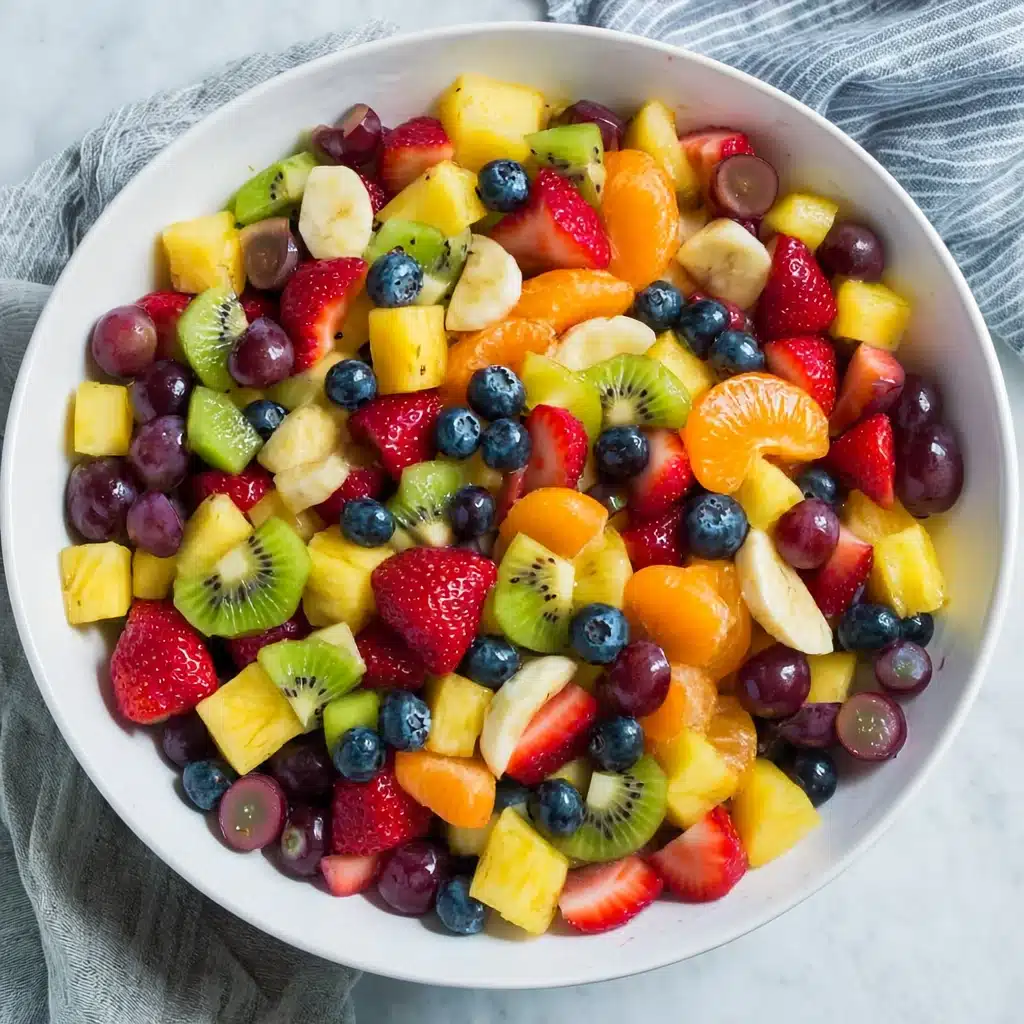
Table of Contents
Table of Contents
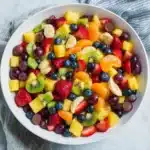
Summer Fruit Salad – Fresh & Healthy Seasonal Recipe
- Total Time: 45 min
- Yield: 6 1x
Description
This refreshing summer fruit salad is packed with ripe, juicy berries, melons, and tropical fruits tossed in a light citrus-honey dressing. It’s the perfect healthy side or snack for warm days — quick to make, naturally sweet, and full of vibrant summer flavor.
Ingredients
- 1 cup strawberries, hulled and halved
- 1 cup blueberries, rinsed
- 1 cup watermelon, cubed
- 1 cup mango, peeled and diced
- 1 cup green grapes, halved
- 1 kiwi, peeled and sliced
- 2 tablespoons fresh lime juice
- 1 tablespoon honey (optional)
- 5–6 fresh mint leaves, torn
Instructions
- Wash & prep all fruits. Let them dry completely to avoid a soggy salad.
- Chop fruits evenly into bite-sized pieces. Use a sharp knife for clean cuts.
- Combine fruits in a large chilled bowl. Toss gently using a spatula.
- In a small bowl, whisk together lime juice and honey.
- Drizzle dressing over the fruit mixture and toss lightly to coat.
- Add mint leaves and gently mix in.
- Refrigerate the salad for 30 minutes before serving for best flavor.
- Serve chilled in individual bowls or a decorative glass dish.
Notes
- For the freshest summer fruit salad, use fruits that are in season and fully ripe — this boosts both flavor and texture.
- To avoid sogginess, add delicate fruits like bananas and kiwi just before serving.
- Lightly toss — overmixing can bruise soft fruits and make the salad watery.
- Want to make it ahead? Prep the fruits, store them separately, and mix with dressing just before serving.
- Feel free to get creative with add-ins: pomegranate seeds, toasted coconut, or even a splash of coconut water can transform your salad.
- Avoid freezing this salad — it’s meant to be enjoyed fresh and chilled, not frozen.
- Prep Time: 15 min
- Cook Time: 30 min
- Category: Salads, Snacks, Side Dishes
- Cuisine: American, Tropical, Mediterranean
Nutrition
- Serving Size: ~1 cup per person
- Calories: 98 kcal
- Sugar: 19 g
- Sodium: 1 mg
- Fat: 0.3 g
- Saturated Fat: 0.05 g
- Carbohydrates: 24 g
- Fiber: 3 g
- Protein: 1 g
What Is a Summer Fruit Salad?
Defining Summer Fruit Salad
A fresh fruit salad is a staple during the warmer months, thanks to its light texture and naturally sweet flavor. It typically features a mix of seasonal favorites like watermelon, peaches, grapes, strawberries, and blueberries. The combination of bright colors and juicy textures makes it perfect for outdoor meals, light desserts, or quick, healthy snacks.
What defines this summer-friendly dish is its emphasis on using ripe, in-season fruits that require little enhancement. You don’t need added sugars or syrups — just nature’s best, served chilled. It can be tossed with citrus juice or garnished with mint, making it endlessly customizable for taste and presentation.
Seasonal Benefits of Summer Fruits
Choosing summer fruits means enjoying them at peak flavor and nutritional value. Fruits like berries, melons, and stone fruits are rich in hydration, antioxidants, and natural sugars — ideal for warm-weather energy boosts. Seasonal produce also supports local farming and sustainability.
Here’s a glance at some popular summer fruits and when they’re at their best:
| Fruit | Nutritional Highlights | Peak Season |
|---|---|---|
| Watermelon | Hydrating, high in lycopene | June to August |
| Strawberries | Rich in vitamin C | May to July |
| Blueberries | Antioxidants, fiber | June to August |
| Mango | Vitamin A and folate | May to September |
Want something fruity to pair with your meals? Check out our summer strawberry apple punch for a refreshing drink idea.
Key Ingredients for a Fresh and Vibrant Fruit Salad
Best Fruits to Use for Summer Fruit Salad
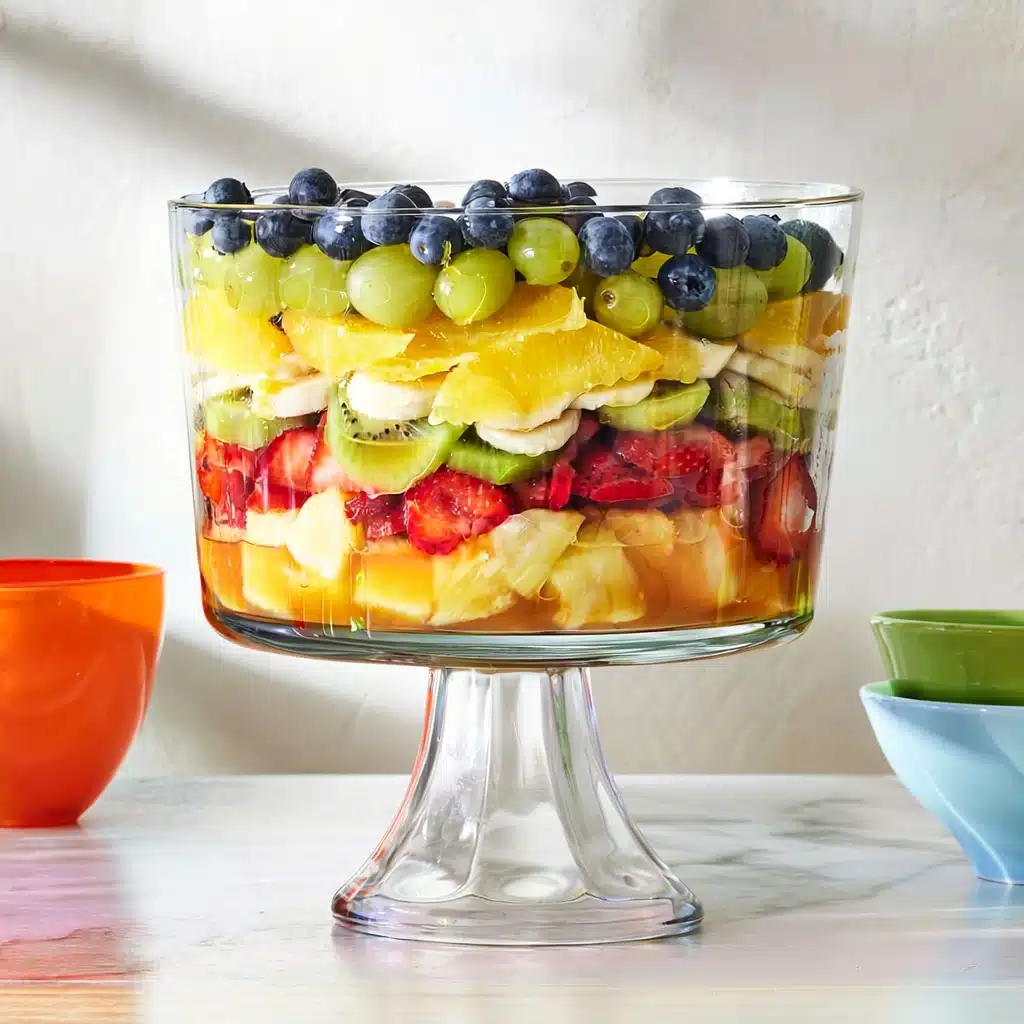
Crafting a delicious summer fruit salad starts with choosing the right fruits. Summer offers an abundance of options that are sweet, juicy, and packed with flavor. The key is to use fruits that complement each other in both texture and taste while holding up well when mixed.
Here are some of the best fruits to include:
- Strawberries: Sweet and slightly tangy, they add vibrant color and a soft bite.
- Blueberries: Small, juicy, and perfect for adding a pop of color and antioxidants.
- Watermelon: Extremely hydrating and naturally sweet — a summer salad essential.
- Mango: Creamy and tropical, it adds a bold, juicy flavor.
- Grapes: Crunchy and refreshing; go for seedless red or green varieties.
- Pineapple: Tart and tropical, great for contrast.
- Kiwi: Adds a citrusy punch and striking visual appeal.
Always opt for ripe, fresh, and unbruised produce. When possible, buy organic or from local farmers markets to ensure quality and peak-season ripeness.
Fruits to Avoid in Your Salad (Why and When)
Not every fruit plays well in a summer fruit salad. Some can become mushy, overly acidic, or even turn other fruits soggy. To maintain the texture and freshness of your dish, it’s best to leave certain fruits out — or add them with caution.
Fruits to use carefully or skip:
- Bananas: Oxidize quickly and become mushy.
- Apples: Tend to brown unless treated with citrus and can overpower the salad’s flavor.
- Avocados: Though technically a fruit, their creamy texture doesn’t mix well with juicy fruits.
- Overripe melons: May become watery and dilute the flavor of other fruits.
If you do want to include any of these, add them just before serving and mix them in gently. That way, they won’t compromise the salad’s texture or shelf life.
Discover great ideas like these easy smoothie recipes if you’re looking to use up soft or overripe fruits in other refreshing ways.
Preparation Tips to Keep Fruit Fresh and Flavorful
How to Cut and Store Fruits Properly
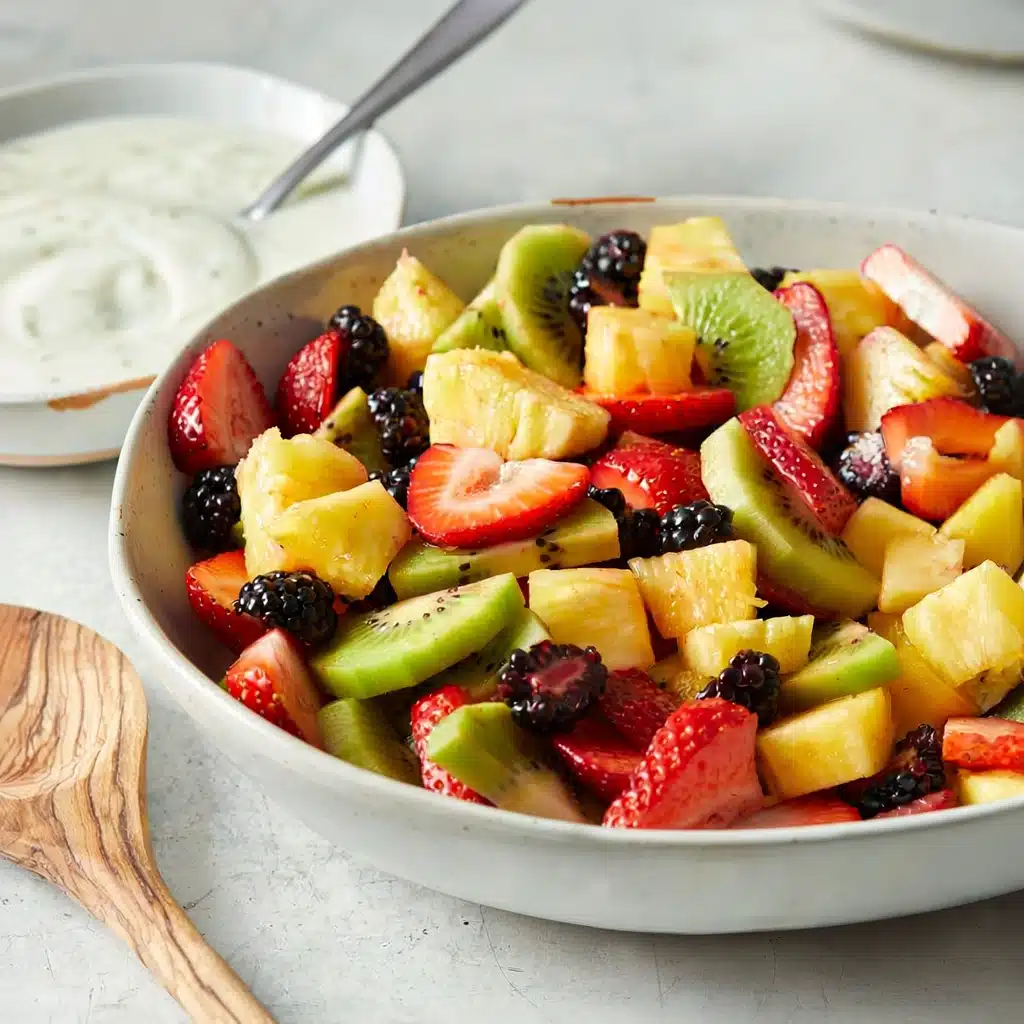
When preparing a summer fruit salad, how you cut and store the fruit is just as important as the ingredients you choose. Cutting fruits evenly not only improves the presentation but also ensures a balanced taste in every bite. Use a sharp knife and cut the fruit into bite-sized, uniform pieces so that textures complement each other instead of clashing.
Tips for prepping your fruit:
- Wash all fruit thoroughly and let it dry completely before slicing.
- Remove stems, seeds, pits, and peels where necessary.
- Use separate cutting boards for acidic fruits like pineapple and citrus to avoid cross-contamination.
- Chill the fruit for at least 30 minutes before serving for a crisper texture.
To store, place your chopped fruit in an airtight container and refrigerate. Line the bottom of the container with a paper towel to absorb excess moisture and keep everything fresh longer. If you’re not serving immediately, wait to add more delicate fruits (like berries or bananas) until just before eating.
Preventing Browning: Tricks with Lemon Juice and Other Liquids
One of the most common issues in a summer fruit salad is browning — particularly with apples, bananas, or pears. Enzymatic browning happens when fruit is exposed to air after cutting, and while it’s not harmful, it can make your salad look unappetizing.
Here’s how to prevent browning naturally:
- Lemon or lime juice: A quick toss in citrus juice helps slow oxidation thanks to vitamin C.
- Pineapple juice: Adds a sweet tropical flavor and preserves color.
- Orange juice: Works well for milder citrus flavor while preventing browning.
- Saltwater soak (very light): A 30-second dip in lightly salted water can keep apples from browning.
Use just enough liquid to coat the fruit — you want to preserve the natural flavor without overpowering it. For a balanced taste, mix lemon juice with honey or a splash of orange juice for added sweetness.
If you’re prepping ahead, store the salad in the coldest part of your fridge and cover it tightly. Avoid plastic wrap that presses on the fruit, which can bruise it. Looking for inspiration? Try our stuffed peppers recipe as a hearty dish to serve alongside your fruit salad at outdoor meals.
How to Make a Summer Fruit Salad That Wows
Step-by-Step Summer Fruit Salad Recipe Guide
Creating a memorable summer fruit salad doesn’t require fancy techniques — just fresh ingredients, good timing, and a bit of creativity. Here’s a simple step-by-step method that brings out the best in every bite.
Ingredients
- 1 cup strawberries (hulled and halved)
- 1 cup blueberries
- 1 cup watermelon (cubed)
- 1 cup mango (peeled and diced)
- 1 cup green grapes (halved)
- 1 kiwi (peeled and sliced)
- 2 tablespoons freshly squeezed lime juice
- 1 tablespoon honey (optional)
- A few fresh mint leaves (torn)
Instructions
- Prep the fruit: Wash, dry, and cut all fruits as directed above. Make sure sizes are consistent.
- Mix dressing: In a small bowl, whisk lime juice and honey until combined.
- Combine gently: In a large mixing bowl, add all fruits and drizzle with the dressing. Toss gently using a spatula — avoid overmixing.
- Garnish and chill: Add mint leaves, then cover and refrigerate for at least 30 minutes before serving.
This refreshing salad is best served chilled and eaten the same day for optimal texture and taste. It’s naturally sweet, hydrating, and balanced — everything a summer fruit salad should be.
Customization Ideas for Texture, Color, and Flavor
One of the best parts of making a summer fruit salad is how easily you can make it your own. Whether you’re aiming for a tropical twist or a citrus-forward blend, here are ways to level up your creation.
To change up the texture:
- Add pomegranate seeds for a juicy crunch.
- Sprinkle toasted coconut flakes for subtle sweetness and bite.
- Mix in chopped nuts like almonds or pecans (just before serving to keep them crisp).
To elevate flavor:
- A splash of coconut water adds a light, island-inspired feel.
- Zest from oranges or lemons brings brightness without added sugar.
- Use basil or mint as alternative herbs for more complex flavor.
To play with color and presentation:
- Layer fruits in a glass trifle bowl for a show-stopping centerpiece.
- Use melon baller tools for perfect round fruit bites.
- Serve in mini mason jars or scooped-out watermelon bowls for portioned servings.
Don’t miss our bang bang chicken if you’re serving your fruit salad as a side — it’s a bold, spicy contrast to the light sweetness of the dish.
Dressings and Liquids: What Goes Well in a Fruit Salad?
Simple Citrus and Honey Dressing Recipes
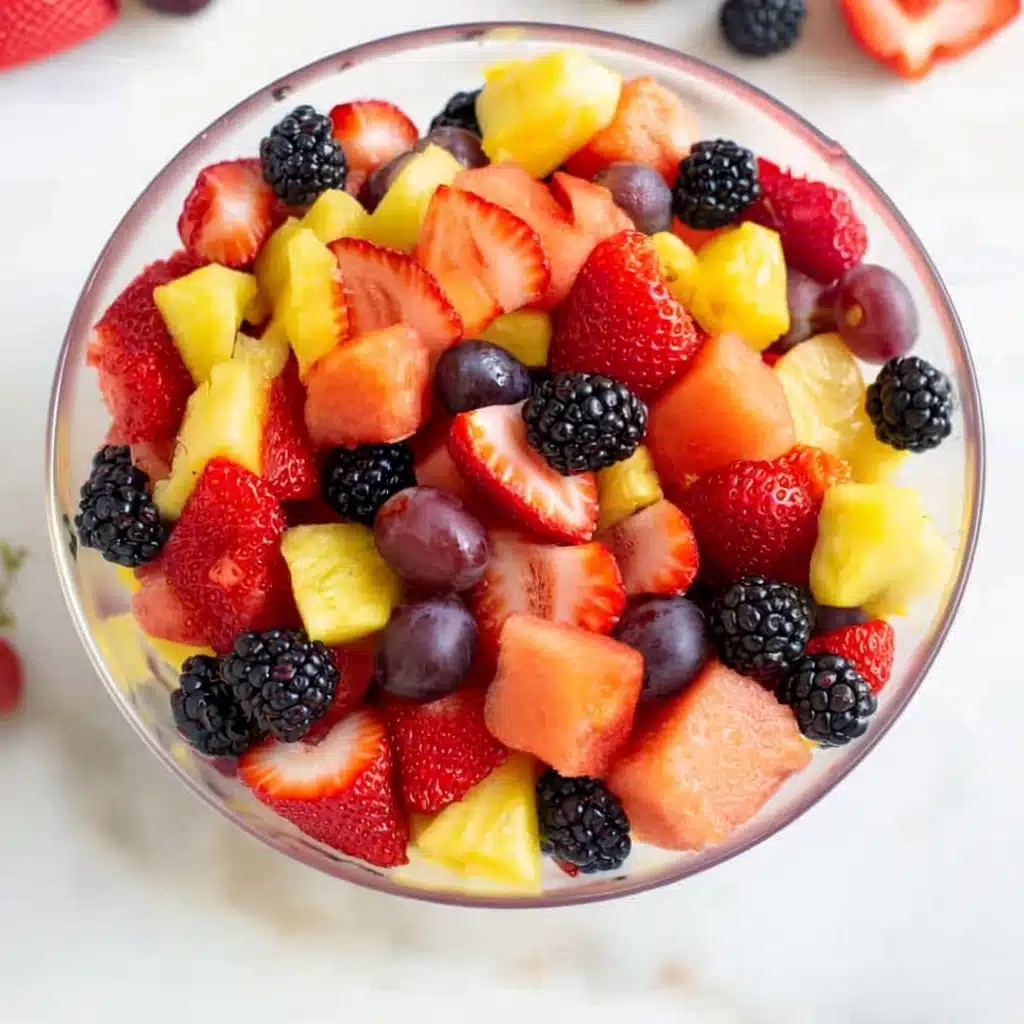
A well-balanced dressing can take your summer fruit salad from good to unforgettable. While the fruit brings natural sweetness, a light citrus-based dressing adds brightness, enhances flavors, and helps preserve the fruit’s freshness. The key is to keep it simple — you want to complement the fruit, not cover it up.
Here are two quick, crowd-pleasing dressings:
1. Classic Citrus-Honey Glaze
- 2 tbsp fresh lime juice
- 1 tbsp orange juice
- 1 tbsp honey
- Zest of 1 lime
Whisk all ingredients together and pour over the fruit just before serving. It adds a sweet-tart kick that ties the entire salad together.
2. Maple-Mint Dressing
- 2 tbsp lemon juice
- 1 tbsp maple syrup
- A few chopped mint leaves
This one’s ideal if you want a more herbal, earthy flavor profile. It pairs well with tropical fruits like mango and pineapple.
When using dressings, add only enough to coat the fruit lightly. Overdressing can make your summer fruit salad soggy and overpower the natural flavors.
Healthy Alternatives: Mint Water, Coconut Water, and More
For those seeking lighter, hydrating options, there are plenty of dressings that go beyond the typical citrus base. These liquids not only add flavor but also keep your fruit salad fresher for longer.
Coconut Water:
Mildly sweet and super hydrating, coconut water blends seamlessly into tropical-style fruit salads. It also helps preserve delicate fruits like kiwi and banana.
Mint-Infused Water:
Soak a few sprigs of fresh mint in cold water for 30 minutes. Use it to gently toss your fruit. It adds a cooling effect and a hint of flavor without sugar.
Sparkling Water with Citrus:
Tossing fruit with a small splash of lemon-flavored sparkling water adds a playful fizz and tartness that can make your salad more refreshing.
Yogurt-Based Light Drizzle:
For a creamy twist, mix Greek yogurt with honey and a bit of vanilla. This works better when served immediately to avoid breaking down softer fruits.
Not sure what to serve alongside your salad? Check out our lunch ideas for savory dishes that round out a balanced summer meal.
Nutrition and Health Benefits of Summer Fruit Salad
Vitamins, Antioxidants, and Fiber in Summer Fruits
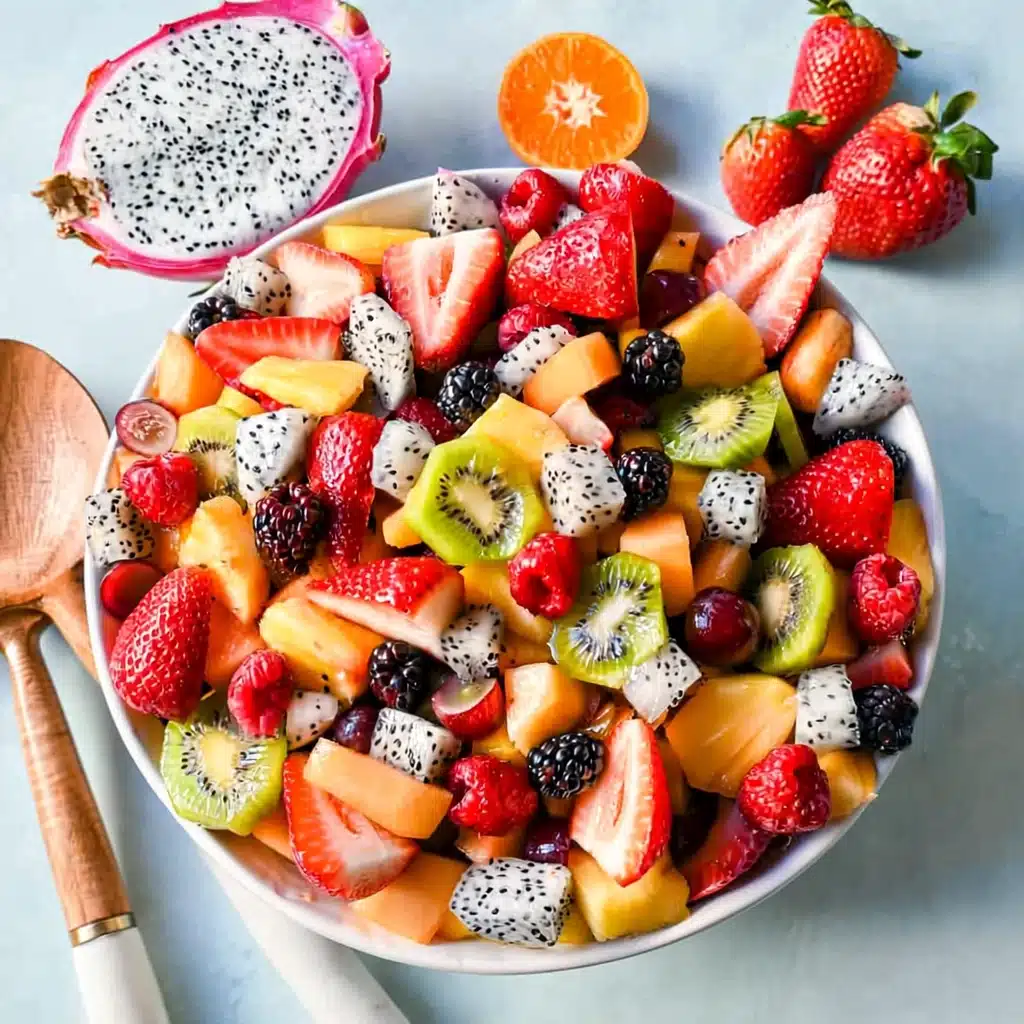
A colorful summer fruit salad isn’t just beautiful to look at — it’s a powerhouse of essential nutrients. Each fruit you include adds unique health benefits, making this dish a delicious way to support your well-being during the warmer months.
Let’s break down the nutritional value of popular fruits commonly used:
| Fruit | Key Nutrients | Health Benefit |
|---|---|---|
| Strawberries | Vitamin C, manganese, folate | Boosts immunity and supports skin health |
| Blueberries | Antioxidants, fiber | Improves brain function, heart health |
| Mango | Vitamin A, vitamin C | Enhances vision, aids digestion |
| Watermelon | Lycopene, hydration, vitamin A | Supports hydration and reduces inflammation |
| Grapes | Vitamin K, polyphenols | Promotes bone health and heart protection |
| Kiwi | Vitamin E, potassium, fiber | Aids in digestion and immune defense |
When combined in a summer fruit salad, these ingredients offer a diverse range of antioxidants, natural sugars, and anti-inflammatory compounds. And because they’re low in calories and high in water content, fruit salads are naturally filling and hydrating.
Low-Calorie, Hydrating, and Gut-Friendly Benefits
One of the most appealing benefits of a summer fruit salad is that it’s incredibly satisfying without being heavy. Most fruits are over 80% water, which helps with hydration — especially important during hot summer days. The high fiber content supports digestive health, helping to regulate blood sugar levels and prevent bloating.
Because there’s no cooking involved, all the vitamins and enzymes in the fruit stay intact. This makes fruit salad one of the cleanest, most nutrient-dense dishes you can add to your summer menu.
For anyone watching calories, a typical serving of fruit salad contains only around 100–150 calories — yet it provides a strong dose of nutrients, flavor, and hydration.
Looking for inspiration? Try our dinner options to complement a light and healthy summer fruit salad for a complete meal.
Common Mistakes to Avoid When Making Fruit Salad
Overmixing or Premixing the Wrong Fruits
Even the freshest summer fruit salad can go wrong if you’re not careful with preparation. One of the most frequent mistakes people make is overmixing. When fruit is stirred too much or too hard, it bruises easily, turning mushy and releasing excess juice that waters down the flavor.
Another common issue? Premixing the wrong fruit combinations. Some fruits, like bananas or overripe peaches, break down quickly and don’t hold up well when tossed with firmer options like apples or melon. If you’re making your salad ahead of time, it’s important to know which fruits should be added last.
Avoid these pitfalls:
- Mixing all fruits hours before serving
- Using fruit that’s too ripe or unevenly cut
- Skipping a light acid (like citrus juice) to preserve color and flavor
To keep your summer fruit salad fresh and vibrant, add delicate fruits just before serving and always mix gently using a silicone spatula or clean hands.
Storage Mistakes That Kill Freshness
Storing fruit salad incorrectly can ruin texture, flavor, and even cause spoilage. Many people cover their salad bowls with plastic wrap and toss them into the fridge. While quick, this method traps moisture and speeds up fruit breakdown.
Best practices for storing fruit salad:
- Use airtight glass containers instead of plastic to prevent odor absorption
- Line the bottom of the container with a dry paper towel to soak up excess moisture
- Keep fruit salad chilled at 35–40°F (1–4°C) and avoid leaving it at room temperature for over 2 hours
- Don’t add dressings or liquids until right before serving
Following these steps ensures your fruit salad stays crisp, colorful, and full of flavor — even if you prep it a few hours in advance.
Need a creative, make-ahead side dish for summer parties? Discover this quick and healthy dinner idea that pairs beautifully with fruit-based recipes.
Serving and Presentation Ideas for Summer Gatherings
Picnic-Perfect Fruit Salad Containers and Tools
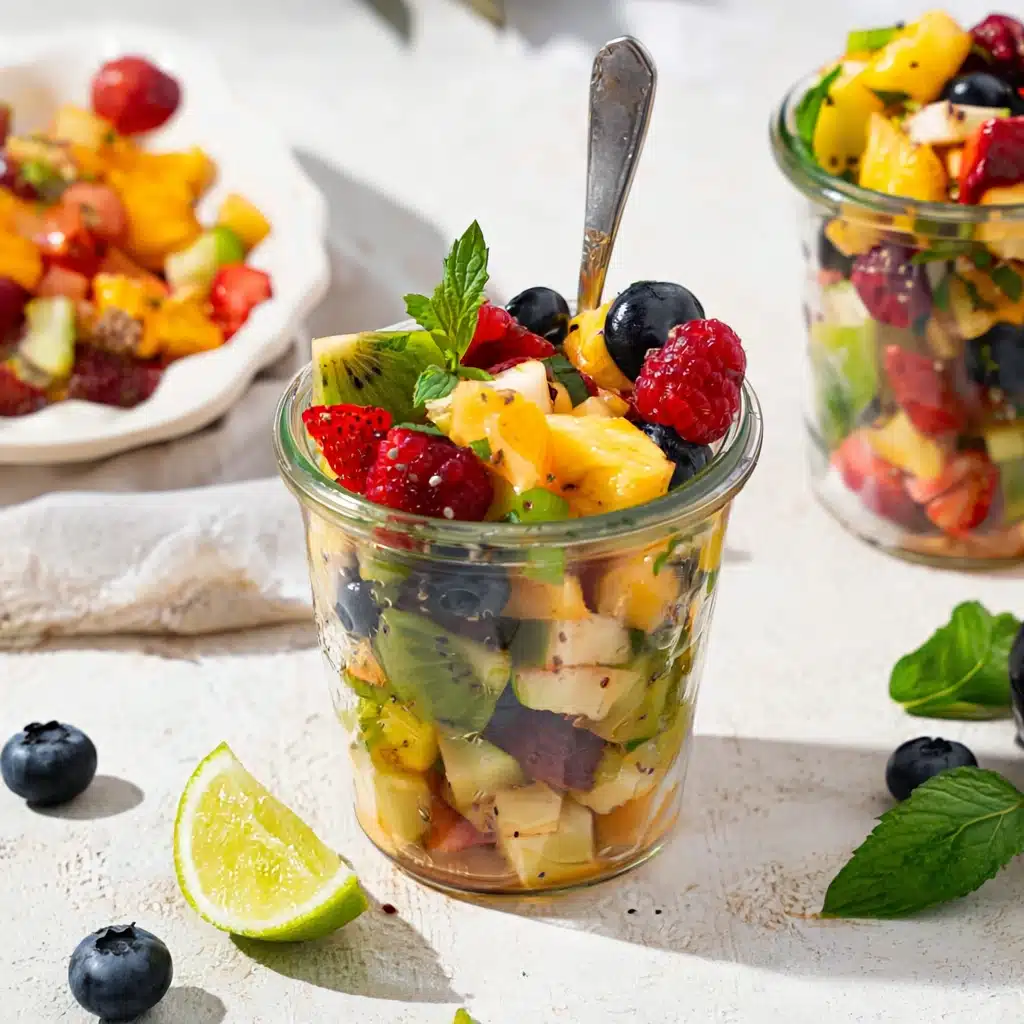
When it comes to summer entertaining, presentation matters — and your summer fruit salad deserves to shine just as much as the main dish. Serving fruit in creative, eye-catching ways doesn’t just make it more inviting, it can also enhance the eating experience.
If you’re packing fruit salad for a picnic, consider using BPA-free plastic or glass containers with tight-fitting lids. These keep everything fresh and make transport easier. Opt for wide, shallow containers to avoid squishing soft fruits like berries or kiwi. For individual servings, mason jars or small compostable cups are both practical and charming.
Essential tools to elevate your presentation:
- Melon baller: For creating perfectly round, uniform bites
- Citrus zester: To garnish with colorful curls of lemon or orange peel
- Chilled bowls or platters: Keep the fruit cool and crisp in warm weather
- Ice bed or tray: Use underneath your serving bowl if you’re outside for extended periods
Adding a few mint sprigs or edible flowers on top can also give your summer fruit salad an elegant touch, perfect for brunches or garden parties.
Creative Garnishing and Bowl Styles to Impress Guests
Fruit salad can go from casual to upscale with a few artistic touches. The presentation doesn’t have to be complicated — just thoughtful. Here are a few ideas:
- Serve in a watermelon bowl: Hollow out half a watermelon and use it as a natural serving dish.
- Layered trifle: Build your salad in a tall glass trifle dish with alternating fruit colors for a wow-factor centerpiece.
- Mini skewers: Thread cubes of fruit onto toothpicks or skewers for a grab-and-go twist.
- Tropical theme: Serve in coconut shells or hollowed-out pineapples for a beachy vibe.
If you want to keep your summer spread cohesive, don’t miss our breakfast ideas — they offer colorful and refreshing dishes that complement fruit salad perfectly.
Variations and International Twists on Summer Fruit Salad
Tropical Fruit Salad with Coconut Flakes
If you’re ready to go beyond the classic, try giving your summer fruit salad a tropical makeover. This version swaps out traditional berries for juicy, exotic fruits that transport you straight to island paradise.
Fruits to include:
- Mango
- Pineapple
- Papaya
- Dragon fruit
- Kiwi
- Banana (add just before serving)
Toss these with fresh lime juice and top with unsweetened shredded coconut for added texture and a hint of natural sweetness. To enhance the island flair, drizzle with a light mix of coconut milk and honey, or serve it in a hollowed-out pineapple bowl for extra style points.
This variation not only tastes amazing but also packs in vitamin C, fiber, and hydration — making it a perfect poolside snack or post-BBQ refresher.
Mediterranean Style with Feta and Mint
Craving something with a savory twist? A Mediterranean-inspired summer fruit salad balances sweet and salty for a sophisticated flavor profile. Combine fruits like watermelon, cantaloupe, and grapes with crumbled feta cheese, a few thin slices of red onion, and fresh mint.
Dressing idea:
- 1 tablespoon olive oil
- 1 teaspoon lemon juice
- Pinch of sea salt
This combo of juicy fruits and briny cheese is especially refreshing on hot days and works beautifully as a starter or side for grilled meats. It’s a great way to elevate your salad for dinner parties without adding complexity.
Want more creative dishes that mix sweet and savory? Check out our bang bang chicken recipe — it’s a bold entrée that pairs surprisingly well with fruit-based sides.
Conclusion
A well-made summer fruit salad isn’t just refreshing — it’s the centerpiece of any warm-weather meal. With its vibrant colors, juicy textures, and rich mix of nutrients, this dish proves that healthy can also be delicious. Whether you go classic with berries and melon or experiment with tropical or Mediterranean flavors, there’s truly no wrong way to enjoy it.
Chef Adriana’s debut recipe brings simplicity, balance, and flavor together in one bowl. From choosing the right fruits to storing and presenting them like a pro, you now have everything you need to make a summer fruit salad that delights in both taste and presentation.
So why not head to your local market, grab some seasonal produce, and create your own version today? You’ll find it’s more than just a side — it’s a summer tradition in the making.
Don’t miss our easy smoothie recipes to pair with your fruit salad for a complete, refreshing snack lineup.
Love creating dishes like this summer fruit salad? Join our vibrant community of food lovers on Facebook and Pinterest for even more seasonal inspiration! From refreshing fruit salad variations to savory favorites like stuffed peppers, we share easy, flavorful recipes every week. Discover time-saving kitchen tips, connect with fellow home cooks, and explore new ways to enjoy summer’s best ingredients. Follow us today and never miss a delicious update!
How do you make a fresh fruit salad?
To make a fresh summer fruit salad, start with ripe, seasonal fruits like strawberries, blueberries, watermelon, mango, grapes, and kiwi. Wash and dry each fruit thoroughly, then chop them into bite-sized pieces. Combine them in a large bowl and toss gently with a light dressing made from citrus juice (like lime or orange) and optional honey or mint. Chill for at least 30 minutes before serving for the best flavor.
What fruits should not be mixed in a fruit salad?
Avoid using fruits that oxidize or break down quickly, like bananas and apples, unless you plan to serve the salad immediately. Other problematic fruits include overripe melons and avocados. These can become mushy, watery, or overpowering in texture and flavor. If used, add them just before serving to maintain the freshness of your summer fruit salad.
What are the ingredients of fresh fruit salad?
A classic fresh fruit salad typically includes:
Berries (strawberries, blueberries)
Melons (watermelon, cantaloupe)
Citrus (orange slices, lime zest)
Tropical fruits (mango, pineapple)
Optional add-ins: grapes, kiwi, mint leaves, honey, or a splash of lemon juice
You can mix and match based on what’s in season and your flavor preferences.
What to put on fruit salad to keep it from turning brown?
To prevent browning, especially in fruits like apples, bananas, or pears, use a light coating of acidic juice such as lemon, lime, or orange. A mixture of lemon juice and honey is a popular natural preservative. Tossing fruit in citrus not only keeps the color vibrant but also enhances the overall taste of your summer fruit salad.
How do I keep my fruit salad from turning brown?
Store your salad in an airtight container lined with a dry paper towel to absorb moisture. Keep it chilled and covered until ready to serve. Avoid overmixing and don’t add delicate fruits until the last minute. Using citrus juice will help slow oxidation and maintain appearance.
What liquid goes in fruit salad?
Citrus juices like orange, lemon, or lime are the most common liquids used. They preserve color and brighten flavor. For tropical salads, coconut water or even a splash of fruit-infused sparkling water can be refreshing. Just avoid heavy syrups or dairy-based dressings unless the salad will be served right away.